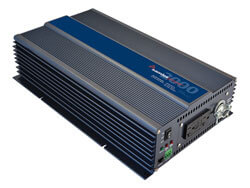I am trying to wire a 24V 2000W inverter to a distribution panel for a shed. My plan was to set it up just like a standard main panel, but as I have come to understand, lots of inverters output AC with 60V on the Line, 60V on the Neutral, and 0V on ground (as opposed to 120/0/0). I know I need to tie the Neutral and ground together in the panel, so I have a fault current path back to the panel, but I cant seem to find an inverter that explicitly will allow me to bond the neutral/ground (presumably because the Neutral is also hot). Specifically I was about to buy the WZRELB 24V 2500W Inverter, but the instructions are crap.
1. Does anyone have a recommendation for a 24V inverter that will safely allow me to hook it up to a breaker panel?
2. Do all 120V inverter split the output between Line/Neutral? Is there an inverter that outputs 12/0/0 (L/N/G) so I dont have to worry about a live Neutral?
3. Does connecting the inverter and grounding bar in the panel to a grounding electrode in the earth do anything to mitigate this issues (ie give a reference for the AC output?) I dont think I'm fully understanding how the inverters work.
Thanks!
1. Does anyone have a recommendation for a 24V inverter that will safely allow me to hook it up to a breaker panel?
2. Do all 120V inverter split the output between Line/Neutral? Is there an inverter that outputs 12/0/0 (L/N/G) so I dont have to worry about a live Neutral?
3. Does connecting the inverter and grounding bar in the panel to a grounding electrode in the earth do anything to mitigate this issues (ie give a reference for the AC output?) I dont think I'm fully understanding how the inverters work.
Thanks!





